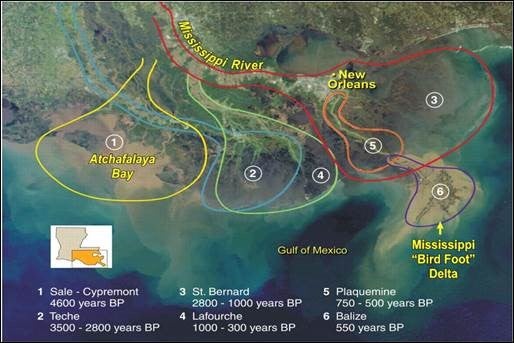Facing Continued Land Loss, Mississippi River Delta Needs Diversions More Than Ever
MODIS Imagery of Louisiana on May 6, 2017 from Louisiana State University’s Earth Scan Laboratory (https://www.esl.lsu.edu/imagery/MODIS/2017/05/6/) showing the sediment plume from the Mississippi River.
The future of the Mississippi River Delta will likely look drastically different than it does now. As sea level rise increases, we need to be smart about where and how we build land along Louisiana’s coast. A viable future for coastal Louisiana means a smaller delta, and using sediment diversions to strategically build and maintain land can make that smaller delta more sustainable.
A new study released this week in Science Advances evaluated the geologic history of the Mississippi River Delta to inform its future and the potential impacts from coastal restoration projects. The findings echo those of the Changing Course design competition and the state’s 2017 Coastal Master Plan: we cannot rebuild the delta back to what it was historically, nor can we maintain the delta at its current footprint. But we can do something to avoid the worst-case land loss scenario and create a sustainable future for coastal Louisiana.
From 1,600 to 600 years ago, the Mississippi River flowed down Bayou Lafourche, building areas that we now know as Raceland, Larose and Fourchon. The researchers studied this area to better inform our understanding of the delta cycle — how the river builds land and moves water and sediment around the coast.
Looking at the geologic history of the delta cycle, it is clear that we must use the natural land-building power of the river to preserve coastal areas. Sediment diversions, structures that reconnect the river’s sediment to the coastal wetlands, are crucial to building a smaller, sustainable delta. Researchers working on the Science Advances study agree.
“We’re still convinced that these river diversions are basically the only real shot at getting something done in terms of coastal restoration,” Torbjorn Tornqvist, one of the authors, said in a Washington Post article. “But you have to be really realistic about what you can expect, and it’s going to be have to be very focused on small and carefully selected parts of the delta. It means very difficult choices are going to have to be made.”
Being realistic is important. Even with the master plan implemented, there will still be a net loss of land, but the consequences are much more dire if we don’t do anything. Without action, Louisiana will lose as much as 4,000 square miles of land. This drastic land loss would mean the very future of coastal communities — including New Orleans — and our rich culture would be in question. Therefore, we need to act to preserve as much as possible.
Elizabeth Chamberlain, lead author on the study, told The Times-Picayune, “Realistically, we need to accept the idea that the delta is going to look different. But there’s still a lot we can do.”
She’s 100 percent correct. There’s still a lot we can do to create a sustainable future for the people and wildlife of coastal Louisiana.
Last week, the state and federal government announced they had shaved 22 months off the timeline for the Mid-Barataria Sediment Diversion, a cornerstone of the master plan. Getting projects like Mid-Barataria on the ground sooner is crucial to preventing the worst-case land loss scenario and maintaining as much of the coast as possible.
This study supports a growing realization that change is inevitable in coastal Louisiana. However, I’m optimistic that facing this reality head-on and working together to develop solutions, we can build a future coast that is better than the one today.

